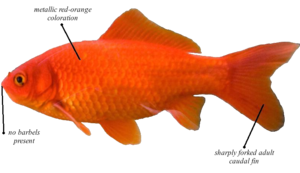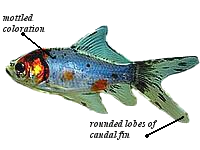Single-tailed Goldfish
Goldfishes have been kept in captivity longer than any other fishes, and many varieties developed from the one original species, Carassius auratis, remain popular. This article is devoted to single-tailed varieties - hardy fishes that can over-winter outdoors. Their cultivation is generally limited to developing exaggerated fins and various color strains.
| Single-tailed Goldfish | |
|---|---|

| |
| Family | Cyprinidae |
| Size | Variable |
| Tank Level | Middle and Lower |
| Temperament | Peaceful |
| Tail Type | Single-tailed |
| Country of Origin | China |
For an in depth tutorial, see our guide
Originating from the Prussian Carp, the Common Goldfish most likely emerged through a form of favoritism. As fish were once kept in captivity for food, fish-keepers may have learned to recognize individuals and then become attached to their charges, and it is likely that an occasional genetic sport, or non-standard colored fish, would appear and draw greater attention. Such fish would be segregated and kept for their appearance rather than their meat, and so the Common Goldfish slowly emerged.
Physical Description
Traditionally, the body color of the Goldfish is metallic red-orange with matching fins. Young fish may be greenish bronze, changing to adult coloration after about one year. Dorsal and anal fins are relatively long based, and the caudal fin is forked and stiffly held. The lateral line is visible. Females usually appear plumper when they are viewed from above. At spawning time the male develops small white spots (tubercles) on the gill covers and head.
History
Kept by man since the 11th century, Carassius auratus (the goldfish) is probably the best known of all aquarium or pond fish. The wild form of this fish is the dull green to brown Prussian Carp, with little to recommend it as a potential aquarium fish, but a mutation occurred which developed lovely gold patches on the body which eventually turned the whole fish gold. The goldfish's first recorded breeding in Europe took place in Holland in 1728, but in its native China it has been domesticated since around the 11th century AD.
In the aquarium
In the aquarium the goldfish will inhabit the middle and lower levels, and eats flakes, vegetation, live foods, and bloodworms. They are generally peaceful, and can grow up to two feet long. However, if placed in an aquarium that is too small, the goldfish will stop growing when it runs out of room. When this happens the internal organs do not stop growing, causing a painful, stunted death for the fish. Generally speaking a goldfish should be placed no more than nine inches of fish (two four-and-a-half inch fish, or one nine inch fish) per 10 gallons of water.
Goldfish are noted for being messy, greedy feeders that produce a lot of waste. Needless to say they require a very efficient filtration system to cope with this.
Related Topics
Parent topics
 Fish: Any aquatic vertebrate animal that is typically ectothermic (or cold-blooded), covered with scales, and equipped with two sets of paired fins and several unpaired fins. [e]
Fish: Any aquatic vertebrate animal that is typically ectothermic (or cold-blooded), covered with scales, and equipped with two sets of paired fins and several unpaired fins. [e] Animal: A multicellular organism that feeds on other organisms, and is distinguished from plants, fungi, and unicellular organisms. [e]
Animal: A multicellular organism that feeds on other organisms, and is distinguished from plants, fungi, and unicellular organisms. [e] Organism: An individual living individual: a complex, adaptive physical system that acts a integrated unit that sustains metabolism and reproduces progeny that resemble it. [e]
Organism: An individual living individual: a complex, adaptive physical system that acts a integrated unit that sustains metabolism and reproduces progeny that resemble it. [e]- Chordata: Add brief definition or description
- Osteichthyes: Add brief definition or description
- Actinopterygii: Add brief definition or description
- Neopterygii: Add brief definition or description
- Teleostei: Add brief definition or description
- Ostariophysi: Add brief definition or description
- Cypriniformes: Add brief definition or description
- Cyprinioidea: Add brief definition or description
- Cyprinidae: Add brief definition or description
- Carassius: Add brief definition or description
Subtopics
 Comet (goldfish): A goldfish variety developed in 1880 by Hugo Mulertt, and has become one of the best selling aquarium fish since. [e]
Comet (goldfish): A goldfish variety developed in 1880 by Hugo Mulertt, and has become one of the best selling aquarium fish since. [e] Nymph (goldfish): A breed of goldfish descended from the Veiltail and Fantail. [e]
Nymph (goldfish): A breed of goldfish descended from the Veiltail and Fantail. [e] Shubunkin: Also known as "poor mans Koi", the Shubunkin is a breed of goldfish first developed in Japan in the 1900's. [e]
Shubunkin: Also known as "poor mans Koi", the Shubunkin is a breed of goldfish first developed in Japan in the 1900's. [e] Bubble-eye Goldfish: A breed of Goldfish that sports large fluid filled sacs beneath the eyes, a twin tail, and lacks a dorsal fin. [e]
Bubble-eye Goldfish: A breed of Goldfish that sports large fluid filled sacs beneath the eyes, a twin tail, and lacks a dorsal fin. [e]- Celestial Goldfish: Add brief definition or description
- Fantail Goldfish: Add brief definition or description
- Lionhead (goldfish): Add brief definition or description
- Moor (goldfish): Add brief definition or description
- Red-cap Oranda: Add brief definition or description
- Pearlscale (goldfish): Add brief definition or description
- Pom-pom (goldfish): Add brief definition or description
- Veiltail (goldfish): Add brief definition or description
- Japanese Moor: Add brief definition or description
- Red and White Lionhead: Add brief definition or description
- Comet Shubunkin: Add brief definition or description
- Red Ryukin: Add brief definition or description
- Red and White Ryukin: Add brief definition or description
- Red Ranchu: Add brief definition or description
- Red and White Wakin: Add brief definition or description
Bibliography
- Rogers,Geoff. Freshwater Aquarium Fish. 1 ed. Focus on. Buffalo, New York: Firefly Books
- LTD., 2004.
- Mills,Dick. Aquarium Fish. 1 ed. Eyewitness Handbooks. New York, New York: Dorling
- Kindersley, Inc., 1993.
- Bailey,Mary. Aquarium Fish & Fish Care. paperback ed. The Ultimate Encyclopedia of. New
- York, New York: Hermes House, 1999.
| Single-tailed Goldfish | |
|---|---|

| |
| Family | Cyprinidae |
| Size | Variable |
| Tank Level | All |
| Temperament | Peaceful, Schooling |
| Tail Type | Single-tailed |
| Country of Origin | Japan |
For an in depth tutorial, see our guide
Also known as "poor mans Koi", the Shubunkin is a breed of goldfish first developed in Japan in the 1900's.
Physical Description
The bodies of the Shubunkin varieties are slightly shorter than those of the Common Goldfish, but they are similarly rounded. Shubunkin coloration depends very much on strain and on scale formation: the popular strains tend to show blacks, reds, purples, blues, and browns beneath pearly matte scales. The strain shown at right is the Bristol Shubunkin, which features an extravagant caudal fin. Its pronounced rounded lobes are carried without drooping on a good specimen.
Another popular strain, the London Shubunkin, is the same shape as the Common Goldfish, but it is multi-colored and lacks the metallic scales. Its fins are not artificially developed.
History
The Shubunkin was first bred from mutations in Moor goldfish in the 1900's in Japan. They are commonly referred to as "poor mans Koi", due to the similar coloration and body shape.
In the aquarium
The Shubunkin behaves much like the Koi, in that it does better outdoors than in an aquarium. Shubunkin are very hardy, and will eat all the foods of typical goldfish.
Gallery
Related Topics
Parent topics
 Fish: Any aquatic vertebrate animal that is typically ectothermic (or cold-blooded), covered with scales, and equipped with two sets of paired fins and several unpaired fins. [e]
Fish: Any aquatic vertebrate animal that is typically ectothermic (or cold-blooded), covered with scales, and equipped with two sets of paired fins and several unpaired fins. [e] Animal: A multicellular organism that feeds on other organisms, and is distinguished from plants, fungi, and unicellular organisms. [e]
Animal: A multicellular organism that feeds on other organisms, and is distinguished from plants, fungi, and unicellular organisms. [e] Organism: An individual living individual: a complex, adaptive physical system that acts a integrated unit that sustains metabolism and reproduces progeny that resemble it. [e]
Organism: An individual living individual: a complex, adaptive physical system that acts a integrated unit that sustains metabolism and reproduces progeny that resemble it. [e]- Chordata: Add brief definition or description
- Osteichthyes: Add brief definition or description
- Actinopterygii: Add brief definition or description
- Neopterygii: Add brief definition or description
- Teleostei: Add brief definition or description
- Ostariophysi: Add brief definition or description
- Cypriniformes: Add brief definition or description
- Cyprinioidea: Add brief definition or description
- Cyprinidae: Add brief definition or description
- Carassius: Add brief definition or description
Subtopics
 Comet (goldfish): A goldfish variety developed in 1880 by Hugo Mulertt, and has become one of the best selling aquarium fish since. [e]
Comet (goldfish): A goldfish variety developed in 1880 by Hugo Mulertt, and has become one of the best selling aquarium fish since. [e] Nymph (goldfish): A breed of goldfish descended from the Veiltail and Fantail. [e]
Nymph (goldfish): A breed of goldfish descended from the Veiltail and Fantail. [e] Common Goldfish: Add brief definition or description
Common Goldfish: Add brief definition or description Bubble-eye Goldfish: A breed of Goldfish that sports large fluid filled sacs beneath the eyes, a twin tail, and lacks a dorsal fin. [e]
Bubble-eye Goldfish: A breed of Goldfish that sports large fluid filled sacs beneath the eyes, a twin tail, and lacks a dorsal fin. [e]- Celestial Goldfish: Add brief definition or description
- Fantail Goldfish: Add brief definition or description
- Lionhead (goldfish): Add brief definition or description
- Moor (goldfish): Add brief definition or description
- Red-cap Oranda: Add brief definition or description
- Pearlscale (goldfish): Add brief definition or description
- Pom-pom (goldfish): Add brief definition or description
- Veiltail (goldfish): Add brief definition or description
- Japanese Moor: Add brief definition or description
- Red and White Lionhead: Add brief definition or description
- Comet Shubunkin: Add brief definition or description
- Red Ryukin: Add brief definition or description
- Red and White Ryukin: Add brief definition or description
- Red Ranchu: Add brief definition or description
- Red and White Wakin: Add brief definition or description
- Bubble-eye Goldfish [r]: A breed of Goldfish that sports large fluid filled sacs beneath the eyes, a twin tail, and lacks a dorsal fin. [e]
- Anti-intellectualism [r]: Add brief definition or description
Bibliography
- Rogers,Geoff. Freshwater Aquarium Fish. 1 ed. Focus on. Buffalo, New York: Firefly Books
- LTD., 2004.
- Mills,Dick. Aquarium Fish. 1 ed. Eyewitness Handbooks. New York, New York: Dorling
- Kindersley, Inc., 1993.
- Bailey,Mary. Aquarium Fish & Fish Care. paperback ed. The Ultimate Encyclopedia of. New
- York, New York: Hermes House, 1999.
Single-tailed Goldfish/Bibliography
Parent topics
- Coldwater cyprinids [r]: Add brief definition or description
- Cyprinids [r]: Add brief definition or description





